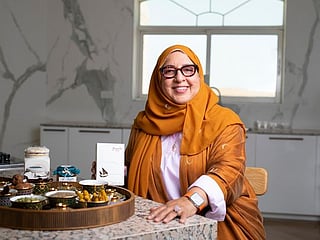An Indian in California: How molecular biologist Nik Sharma became a celebrated recipe developer
He has authored two cookbooks and explains why you should use Tellicherry black peppercorn

Also In This Package
Two Emirati sisters celebrating UAE culinary heritage

Emirati woman food entrepreneur on PappaRoti’s success

Jagdishbhai Thanki: Dish-washer to top UAE restaurateur

Eat flowers, dresses with UAE cake artist Reema Siraj

Dubai: Like many of his generation - he moved to the US from India, 20 years ago to study molecular biology. Science was the escape to a better life, a path to a successful career and in his case some personal travails. But, as they say, man proposes, God disposes. Things didn’t go as planned, perhaps they turned out way better!
Today, Nik Sharma is a celebrity food photographer, recipe developer, cook book author, and a food columnist.
So how did a young Indian student go from being a science researcher to a celebrity in the culinary world?
The 41-year-old was brought up in a bi-cultural Indian household, to a North Indian father, from the state of Uttar Pradesh and a Goan (natives of the coastal state in West of India, once a former Portuguese colony) mother. His childhood and early youth was spent in Mumbai, India. Nik Sharma narrated to Food by Gulf News from his residence in California that the multiple cultural exposure ensured food played an important role in his growing up years, but he never saw it as a career option. He chose molecular biology as the way forward.
Sharma’s journey was unplanned. “One thing led to another… I didn’t see myself here, like 10 years ago I did not picture myself doing this. I thought I would be in science or some kind of research position, well… it’s just that the nature of my research has changed.”
After he arrived in the US two decades ago, he realised that funding in research was a bleak situation, especially for post-doctoral programmes. Sharma was suddenly unsure if he wanted to continue on this career path. “I would see a lot of my professors and research labs shutdown as they were no longer getting grants to support and to get in a career with a PhD, where you still don’t make enough money, is very frustrating. So that made me a little bit jaded.” For someone who had moved from India to the US for graduate school, the return on investment, be it in terms of time or money, mattered a lot. But, he decided to stick with it.
Sharma lived in the state of Ohio and later moved to Washington D.C., where he loved working as a researcher at Georgetown Hospital. He enjoyed the independence and creative freedom that he got during this time. But the state of funding remained a constant cause of worry. However, food and food photography was always a source of joy. So, during this time he launched his blog, as a break from all the stress, called ‘abrowntable’. And that was the beginning of a new journey. The meticulous attention to detail that scientific research demands, he brought to his food photography.
Eventually, he realised that he had probably found his niche – Sharma wanted to get into a cooking school, but, again, the practical concern of student loans and a career to repay it was a cause of concern. “In cooking school, it does not mean that you will end on a TV show, as a lot of people think they will become famous. In fact it’s the toughest jobs to be in, it’s the grind and if anything that has proven that being in the hospitality industry is terrible, is Covid-19.”
So instead, Sharma decided to work as a pastry chef in San Francisco, before joining a culinary institute. He thoroughly enjoyed his work at the patisserie but after a year and a half, he decided to move to California. It was there, in the year 2016 that his career truly transitioned. He ended but getting a job as a food photographer for a start-up. “Because I was also photographing my own pictures for my blog, it became my portfolio to look for work. I was not actively looking for this job but was in the process of developing my skills.” From that job he expanded his reach into the world of food a bit more.
He reached out to the San Francisco Chronicle news media house, where he wanted to apply for a food photographer’s job. Instead the editor at the food section hired him to write a recipe column and that is how Nik Sharma finally entered the field of culinary writing.
A labour of food research
Today, decades later, his scientific training continues to hold – Sharma tests and retests his recipes at home before penning them down. A kind of research in itself. Read his recipes and you will understand the flavours, layers to it, as he explains which spices or herbs to balance and enhance them with.
In fact, this is very obvious in his second cookbook – The Flavour Equation, the first was Season, an initial foray, it is a work of intense research, which features more than 100 recipes. You’ll completely understand processes such as sautéing an ingredient at a certain temperature, how to enhance and balance flavours and why certain recipes ask for seasoning with salt and not cooking with it. It has all been broken down to basic science.
With this cookbook, Sharma ties in his background as a molecular biologist. He writes: “I explore the different components that make up flavour: our emotions that come into play when we cook and eat, how sight interacts with colors and shapes in our food, how sound affects our perception of flavor, the importance of textural elements in food and ways to build them, how aromas work in the kitchen, and finally, taste. The five basic tastes and the flavour boosters that add: brightness (sourness), bitterness, saltiness, sweetness, and savoy quality (umami), while exploring the richness (the taste of fat) and fieriness in our food.”
But, this attention to detail and specificity is not easy.
“I struggle with writing a lot, it’s difficult very difficult. I know I am a better food photographer and recipe developer than writer,” said Sharma.
Sharma has more than 10 million followers on Instagram. His account – abrowntable has food pictures right from a quick baked branzino in mustard oil, roasted Brussels sprouts with pickled shallots and creamy labneh, brining pumpkin seeds before roasting or the classic Indian chickpea and fried bread dish - Chole Bhature, made with leavened dough, which requires a specific consistency. A labour of love that has finally allowed this scientist to be at home in his favourite lab space – his kitchen and behind the lens of a camera, bringing gastronomy to visual life. Life does work out better than you expect it to!
Here is Nik Sharma’s recipe to try at home
Recipe:
Black Pepper Chicken
Before chilies arrived in India, black pepper was an important ingredient that provided heat in cooking. There are a few different versions of black pepper chicken, some dry and some with a more gravy-like sauce. If you prefer a drier chicken, use half the coconut milk, indicated in the recipe.
Ingredients:
Serves 4 to 6
2 tbsp black peppercorns
1 tsp coriander seeds, ground
1 tsp fennel seeds, ground
2 tsp ground turmeric
2 tbsp fresh lime juice
Fine sea salt
1.4 kg boneless, skinless chicken thighs
2 tbsp coconut oil
2 large onions, cut in half and thinly sliced
4 garlic cloves, peeled and grated
2 piece fresh ginger, peeled and grated
403 ml can full-fat unsweetened coconut milk
2 tbsp chopped cilantro, for garnish
The flavour approach – The heat in the dish comes the pepper. For a more pronounced aroma and taste, use Tellicherry peppercorns, inspired by the South Indian stew of the same name.
Fennel seeds and slow-cooked onions provide sweetness to counteract the heat. Onions contain long chains of fructose molecules called fructans that breakdown on heating to release the sweeter-tasting fructose molecules.
Coconut milk is an emulsion of water, fat, proteins, and sugars that provides creaminess.
Use a fragrant coconut oil to get the full impact of coconut fragrance and flavour in this dish.
Method:
1. Grind the peppercorns to a coarse powder. In a small dry skillet or saucepan, toast the pepper, coriander, and fennel until they just turn fragrant, 30 to 45 seconds. Immediately transfer to a small bowl. Stir in the turmeric and lime juice and season with salt to form a paste.
2. Place the chicken in a large bowl and massage it with the spice paste. Transfer to a large resealable bag or wrap the bowl with plastic wrap and refrigerate for at least four hours, preferably overnight, to marinate.
3. When ready to cook, set the chicken on the kitchen counter to reach room temperature, about 15 minutes.
4. Heat the coconut oil in a large saucepan over medium-high heat. Add the onions and saute for 4 to 5 minutes, until they just turn translucent. Add the garlic and ginger and saute until fragrant, about 1 minute. Add the marinated chicken with any liquid and the coconut milk, bring to a boil over high heat, then turn to low and cook for 10 to 15 minutes, until the chicken is completely cooked and the liquid becomes a thick sauce.
5. Stir occasionally to prevent burning. Remove from the heat, taste and season with salt. Garnish with cilantro and serve with warm rice.
Tell us more about your favourite dishes and recipes at food@gulfnews.com
Sign up for the Daily Briefing
Get the latest news and updates straight to your inbox





